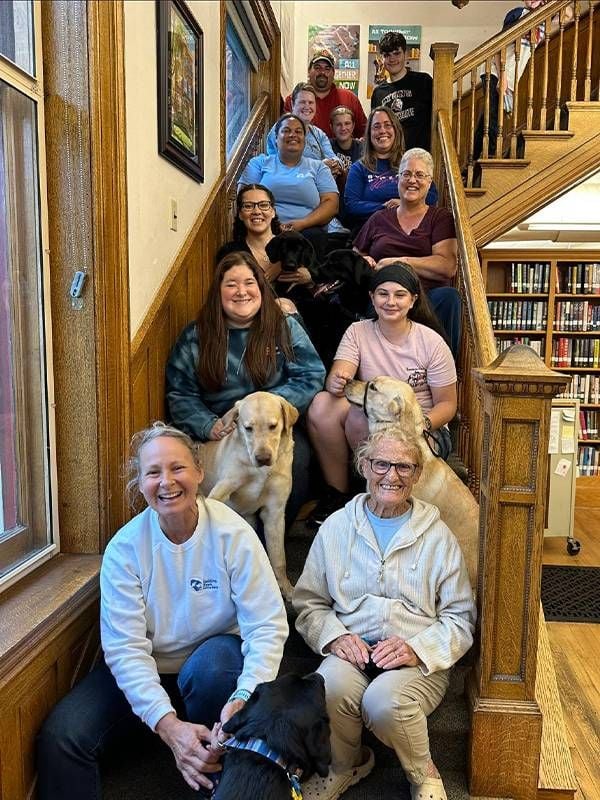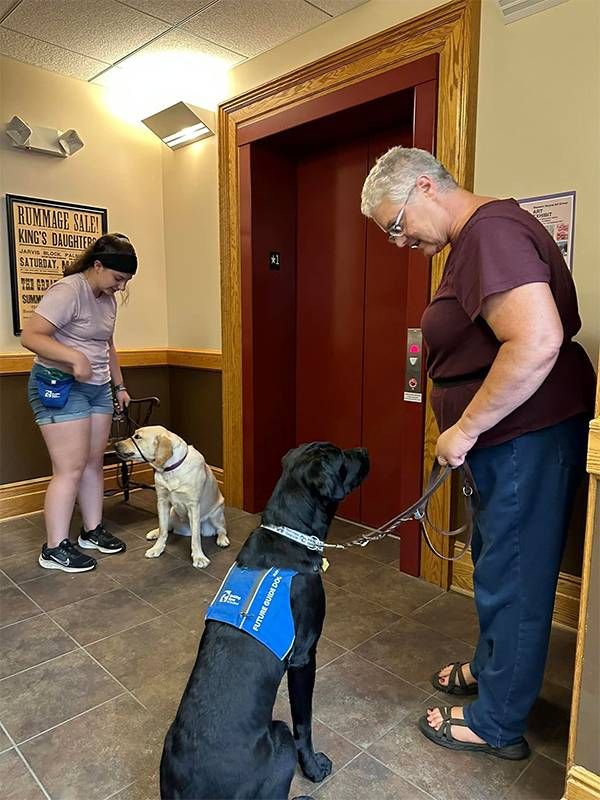Part of the Pack
Intergenerational guide dog raiser groups train puppies to help people with vision loss, and make connections with each other at the same time
What feel-good activity brings diverse people together, squashes ageist stereotypes, and guarantees plenty of wet, sloppy kisses? In upstate New York, a friendly "pack" of guide dog raisers has proven that age is both valuable and irrelevant when it comes to raising the next generation.

Guiding Eyes for the Blind, a nonprofit with chapters in 12 U.S. states on the Eastern Seaboard, Ohio, and Colorado, places specially bred and highly trained guide dogs with individuals with vision loss free of charge, enabling them to live fuller, richer lives.
The Ride of a Lifetime
The organization welcomes volunteers of all ages to serve as puppy raisers; jobs that members say come with perks like new friends and warm, fuzzy cuddles. During the 10 to 14 months that puppies-in-training are with raisers, they learn basic obedience, house manners and practice socialization. These are essential skills that the canines need to master before they go on to the next training phase in order to become working guide dogs.
In the 36 years that volunteer puppy raiser Linda DePuy has been involved with Guiding Eyes for the Blind, the retired rural mail carrier has raised 29 potential guide dogs and has traveled around the world to visit her working success stories.
During the 10 to 14 months that puppies-in-training are with raisers, they learn basic obedience and house manners and practice socialization.
There was Princely, a guide she visited four times in Portugal, and Vassar, another working guide who inspired four trips to Brazil. Her first puppy-raising experience in 1987 also involved travel, but not quite so far from her home in Macedon, New York.
"A gentleman on my mail route who was blind asked if I could find someone to finish raising a dog for Guiding Eyes for the Blind. The rest is history," says DePuy, 71.
DePuy raised the first nine puppies on her own. When puppy number 10 — Princely, a yellow Labrador Retriever — came along, her husband Jim (who passed away in 2016) fell in love and joined her on the journey. Along the way, DePuy says she's found lasting friendships and a lifetime family.
"It's been quite a ride," she says.
With local volunteers aged 12 to 80 from various professional, family, and economic backgrounds, the Wayne County, New York Chapter of Guiding Eyes for the Blind is a diverse group.
Strength in Diversity
"Having volunteers of all ages and walks of life provides great opportunities for the dogs. They get to experience various paces of life and activities that vary quite widely in our puppy raisers and sitters. This makes the dogs well prepared for whomever they might be matched with when they graduate as a guide dog," says volunteer puppy raiser Colleen Kolb, 28, an international educator in Geneva, New York.

Each new volunteer brings unique strengths such as knowledge, technology expertise or administrative experience, and the range of skills helps the group run efficiently.
"In the region, jobs are split up. Someone takes care of the crates, someone takes care of the weights and medicines, someone does our outreach, such as the annual career fair and farmers' markets, and someone does our Facebook," says volunteer region coordinator Beth Walker, 65, an adjunct college professor.
While most volunteers fill the role of full-time puppy raiser, many serve in other vital capacities, such as puppy sitter, co-raiser or puppy "starter." The latter job involves caring for young puppies, who are typically just eight to 10 weeks old and not yet potty-trained when they begin their training journey.
"We get them to the next stage in training where the next person can take over. It can be anywhere from a couple of days to three months," explains Tara Kesel, 43, a Lyons, New York teacher who, along with her children Mackenzie, 12, and Peter, 14, and husband Ray, has fully raised four Guiding Eyes dogs and started another six puppies.
Socialization for Puppies and People
During the 16 years she has volunteered, Guiding Eyes puppies-in-training have been a fixture in Kesel's home and classroom. "It has been wonderful. The kids really get into it. They enjoy making a difference and hearing about the different stages in training," she says.
Kolb, who is one of the group's younger and newer members, joined two years ago after a job relocation. "As a transplant to the area, my volunteer experience has allowed me to meet people and feel more connected to the community here. I don't have family nearby, so it's great to have the support of the Guiding Eyes Group, knowing they care about me as a person," says Kolb.
Although the job is unpaid, Kolb says she's enjoyed plenty of fringe benefits.
"Highlights include the wonderful people I have met and places I have visited as part of the Guiding Eyes program — plus the many, many puppy cuddles, of course!" she says.
It Takes a Village to Make a Difference
First-time raisers Doug and Patt Cochrane, 76, of Naples, New York, also found a new social support network in Guiding Eyes after retiring from special education and nursing careers.
"I don't have family nearby, so it's great to have the support of the Guiding Eyes Group, knowing they care about me as a person."
"Retiring from long careers causes a shift in a person's identity and usefulness. We are now part of our raiser's group where we found commonality in similar interests as well as socialization," says Doug.
In addition to attending the required biweekly puppy classes, facilitated by a professional Guiding Eyes Puppy Instructor, local raisers plan a monthly class outing and help with community outreach. Boat and bus rides, outings to local parades and nature centers, and visits to libraries where children read to puppies are just some of the activities the Cochranes say have helped them engage and stay active.
Retiree Bonnie Kelly, 80, of East Bloomfield, New York, is the group's most "senior" member in age. She has fully raised 15 guide dog puppies and started four more in the 18 years she has been involved with Guiding Eyes. It's been a rewarding experience, she says.
"I found out early in my raising that the unemployment rate is 70% for the visually impaired. Knowing that all the people that have received one of the dogs I raised are employed makes me very happy," says Kelly.
Always In Their Hearts
Volunteer and former Region Coordinator Cindy Swift, 59, of Ontario, first got involved through her children, who raised Guiding Eyes puppies through a local 4-H Club. She and her husband, Paul, joined the pack soon afterward, and other than a few short breaks, the couple has been surrounded by puppies since 1995.

"Once the kids were grown and on their own, my husband and I would still often have two or three Guiding Eyes pups. There might be one who was just there temporarily, or somebody may have needed a long-term sit, like when a college student would go abroad or for just a couple of weeks during finals," she says.
Swift has often started puppies or co-raised with new volunteers who weren't yet sure if they were up to a full-time task. The help and guidance of experienced raisers is valuable, says newer raiser Kolb.
"My first puppy struggled with settling in his crate at night. Thankfully, our region coordinator put me in touch with one of the older, more experienced puppy raisers. Becky was kind enough to brainstorm ideas. I tried out all of her tricks, and soon enough, my puppy was sleeping through the night and so was I," Kolb says.
Kolb says that the "it takes a village" adage applies to raising guide dog puppies as well as children. "I am so grateful to be part of an intergenerational village of puppy raisers," she adds.
Linda DePuy recently took a temporary break from puppy raising, but that hasn't stopped her from helping fellow raisers by attending puppy classes and conducting group outreach. Although she's "always on the go," she takes time to keep tabs on her Guiding Eyes family friends, including the furry four-legged ones.
"Whether you're raising now or not, that part of your life will always be there. The dogs are always in your heart," she says.
How to Get Involved
Guiding Eyes for the Blind actively recruits volunteer puppy raisers in 13 U.S. states. Volunteers seeking alternatives to puppy raising, such as puppy sitters, puppy starters and puppy finishers, are also needed. All potential volunteers for these jobs are required to complete a pre-placement class. For information and a Guiding Eyes chapter near you, visit guidingeyes.org.


